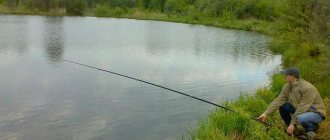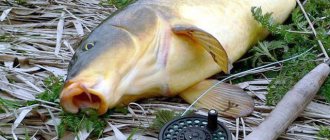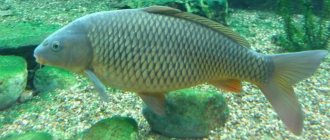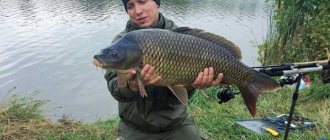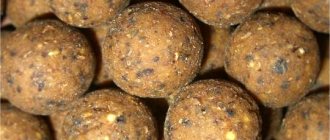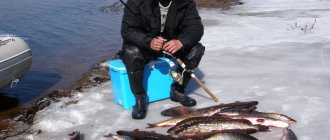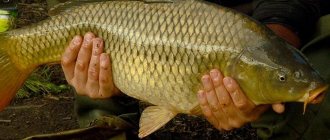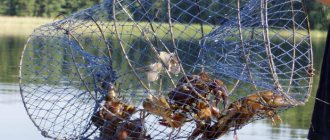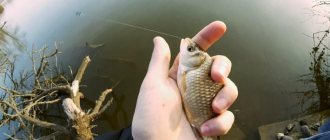For any angler, carp is always a very desirable catch. This is a very interesting and specific breed of fish; you should always approach its fishing individually. Carp often grow to a very large size, so catching one is truly lucky.
Some specialize in carp fishing and know almost everything about the habits of this fish, including the exact time when the spring bite begins, but a lot depends on this. After all, even a properly equipped fisherman, without this information, can return without a single fish.
When is the spring carp bite?
The time when the carp bite begins in the spring is always directly dependent on what behavioral preferences this breed of fish has at that moment.
During the winter months, this fish does not show itself at all. Previously it was believed that she was in a state of suspended animation, like frogs. As it turns out, this is not the case. Carp gather in a school and dive deeper.
There the water does not freeze and remains above four degrees all winter. Cyprinids stay in such pits throughout the winter. It is very difficult to get fish out of there.
Somehow, anglers manage to catch carp even in the winter months, but this is only possible for some professionals, since it is very difficult to activate this fish in cold weather.
Carp can be classified as southern slaves, as they prefer warm water. For this reason, his appetite is greatly influenced by an increase in temperature in the reservoir.
Fishermen know that if carp bites begin, the water has become warm. In cold water conditions, the carp behaves extremely sluggishly, it has no appetite and, accordingly, it will not bite. Previously, it was a common belief that carp begin to bite when the lilac bushes bloom and stop when the rowan berries ripen.
However, today's ecology has clearly made its own adjustments to these signs; climate change is felt throughout the planet. The reference point should be kept at the actual temperature.
Various studies prove that carp become active when the water reaches a temperature exceeding twelve degrees Celsius. Until this moment, carp practically do not bite.
Although, if March is warm and sunny, stagnant reservoirs in shallow waters can warm up well. It is in these places that carp can come out to feed.
Weather conditions or when not to go fishing.
We all know how changeable the weather can be. One day it is too hot, and the fish swim in the upper layers of the water, but do not feed. And on another day it’s windy and cloudy, it seems that there will be a great bite, but there are no signs of fish! Therefore, it is very easy to get confused about the best weather for carp fishing. Carp, like all other aquatic inhabitants, will be influenced to one degree or another by weather conditions such as temperature, wind direction, wind strength, atmospheric pressure and oxygen concentration in the water. Taken together, all these conditions will affect both the location of the carp and how and where the carp will feed. A sudden change in weather can greatly affect the carp's diet and we may have to look for new places for them to go in search of food. Let's take a closer look at some weather conditions.
Wind
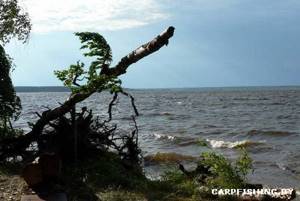
One of the signs of weather that probably all fishermen know about is the wind. Wind direction can have a big impact on where we fish for carp and sometimes how far offshore we cast our rigs. You may have often heard that fish take the bait best when the wind is from the west or southwest. The southwest wind brings warm air, which has a good effect on the feeding of carp. North or East wind mainly brings only cold air. Another old saying goes: “When the wind blows from the West, the fish bite best. When the wind blows from the East, the fish bite the worst!” Wind strength is also important. It has long been noted that the stronger the wind blows, the better the carp feeds. Stronger gusts of wind contribute to an increase in the amount of food on the windward coast. This is one of the reasons why fishing in an area where the wind is in your face will be more productive. I have heard the opinion that in a strong wind, a current arises opposite to the direction of the wind, which will carry away particles of food. It seems to me that such a current (even if it occurs) will not be able to carry particles far from the shore. There are many features of a body of water, such as algae, rocks, depth changes, etc., that will help keep food particles in the coastal zone. I also read that in hot weather strong winds can push the thermocline closer to the bottom. Since carp often follows warmer layers of water, which a strong wind will help lower closer to the bottom, the carp will go to the bottom, where our baits are waiting for it.
Temperature
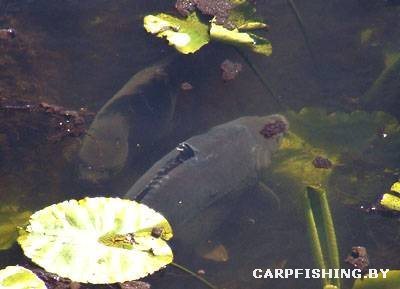
I think the biggest influence on carp nutrition is water temperature. Carp begins to feed at a water temperature of 7C, and the optimal temperature for feeding is 20-28C. If the water temperature drops, the fish begins to look for warmer layers of water, or well-warmed shallow water. For this reason, knowing the location of the fish is probably the most important task when fishing for carp, especially during the colder months. Air and water temperatures have a huge impact on the location and possible feeding of carp. Air temperature has a certain effect on water temperature, it follows that they are related and, to some extent, air temperature can also influence the behavior of carp. If the weather changes and suddenly gets colder, this does not necessarily mean that the water temperature will immediately drop. The air temperature must remain low for at least several days for the water temperature to begin to decrease. Therefore, the deeper the reservoir, the longer the water temperature in it will change. Carps love warmth very much, this explains why they are always looking for warmer layers of water in a pond. Layers of warmer water are present in most lakes, especially deep ones. The depths at which these warmer layers are located vary and depend on the depth of the reservoir and air temperature. Shallow bays and coastal areas often lack these warm layers, but if the sun comes out they will warm up much faster than other parts of the body of water. Therefore, on a cold winter morning, carp can often be found in shallow areas of a reservoir, which are well lit and accordingly warmed up by the sun's rays, despite the fact that there may be warm layers of water in the reservoir itself.
Atmosphere pressure.
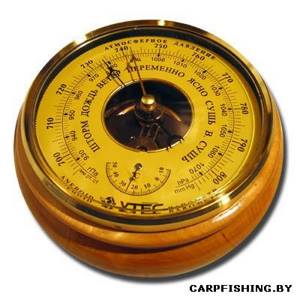
A change in air pressure will cause a change in the oxygen level in the water. Carp need oxygen for normal functioning, including searching for food. If the oxygen level in the water is low, the carp becomes lethargic and lazy, and cannot get enough energy to search for food. High atmospheric pressure usually occurs in the warm season, when there is not enough oxygen entering the water to replace that consumed by fish, plants, etc. Low air pressure often means wind and rain will fill the water with more oxygen. This explains why it is much better to fish for carp on days when the air pressure is low. I always try to go fishing when the air pressure drops, even if I have to fish for carp in the pouring rain. I think it's okay to get a little wet and cold for a good chance of catching a big carp. Wait until the atmospheric pressure drops below 750 mm. Hg st because it will be low. Pressure above 770 mm. Hg st is considered high. The problem with today's climate in the UK is (I think) that high air pressure often persists on rainy days! Atmospheric pressure ultimately affects the depth at which the carp will be found. I once heard from a well-known, authoritative carp angler that carp, at high atmospheric pressure, rises to higher layers of the reservoir, goes to shallower depths, and during periods of low pressure, on the contrary, rushes to the bottom, to greater depths. This is a very important conclusion, because it gives us a general idea of the location of the carp before choosing a place on the shore of the reservoir. But many carp anglers don’t think about the depth at which the carp is currently located. I have seen anglers who fish with bottom boilies in deep water on hot summer days when the atmospheric pressure is very high, and then wonder why they are not biting. Some, however, had one rod with a surface bait thrown in just in case. In this situation, I think the best tactic would be to cast two rigs at different, shallow depths, and the last one with a surface bait. If we can understand why and when carp are in a particular part of the pond, then we can choose the necessary tactics to achieve the best results. Finally. The most important thing that you should always remember is that all of the above conditions are interconnected: wind, atmospheric pressure, water and air temperature, and oxygen content in water. However, I think no matter how good the weather is for carp fishing
The beginning of the main carp fishing season for amateur fishermen
Any fisherman knows that the beginning of the main carp fishing season begins from the moment the fish lay eggs, that is, with the beginning of spawning.
The following circumstances must be fundamental:
- the water should have a temperature of 18 - 26 degrees Celsius;
- The spawning period is considered to be the end of May - beginning of June, when the water is warm;
- just before the start of spawning, the glutton is activated, the fish greedily attacks the food;
- when the water temperature drops, the carp bites less;
- The biting stops around October.
Spring baits for carp
Because carp is omnivorous, it is also called pig. But it must be added that he is fine with caution, and, despite his appetite, it is very difficult to guess exactly what bait he will bite on today. The following are considered traditional baits in spring.
- Crawling out.
- Cancer cervix.
- Pasta.
- Boiled potatoes.
- Peas.
In May, when the water has not yet warmed up or at the end of August, carp “take” live bait more, and on warmer days, they prefer vegetable bait.
In addition to temperature restrictions on bait, it can be divided according to the presence of a permanent food base in the reservoir. But still, first of all, try to catch it on any water and regardless of the weather, you need to use corn, green peas, boilies or boiled potatoes. If there is no bite, you can try other baits.
What are the features of spring carp fishing?
Spring carp fishing has its own specific characteristics, which have been well studied by experienced fishermen.
According to their recommendations, the following must be taken into account:
- In spring, carp prefer to feed in shallow places where the water is better warmed up.
- The fish is very shy, afraid of any noise.
- The tackle should be light and not make any noise when it touches the water.
- It is better not to use a sinker on a float rod.
- The fishing line should be invisible, since in spring in clear water the fish can see it clearly and can swim away.
- Biting activity begins in the afternoon.
- It is important not to overfeed fish in stagnant water.
- The nutritional value of the bait should not be very high.
- It is worth using alcohol-based flavors.
What water temperature encourages carp to wake up?
In winter, carp try to burrow at the bottom, where it is always somewhat warmer. When the water temperature exceeds sixteen degrees Celsius, carps become active and rise from the bottom.
This occurs in the presence of the following factors:
- Rising temperature.
- Establishment of sunny weather.
- Increase in atmospheric pressure.
In rain, fog and low pressure you probably won’t get a bite.
What should the water temperature be for carp to start feeding?
Temperature has a great impact on the activity of fish such as carp. As soon as the water becomes warmer than seven degrees, the carp go for food. The greatest activity in this breed of fish appears at twenty-eight degrees of environment.
Conditions in a home pond
For a comfortable stay of carp in a pond, the depth of the reservoir must be at least one and a half meters. Water in a pond that is too deep will not be able to warm up well and will remain cold, and cyprinids are heat-loving fish species.
The volume of the reservoir should be approximately 8 tons. This means that the minimum size of the pond should be 3 meters in width and length. To prevent water from flowing out of the reservoir, you need to equip its bottom with brick, concrete or clay. You can line the bottom with film. You should be very careful when constructing the bottom so that the water in the pond does not decrease in the future.
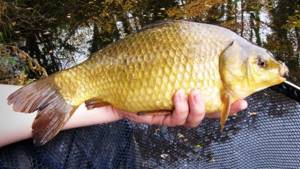
Lighting also plays an important role. You will need to think about the location of the reservoir so that the maximum amount of light falls on its surface, and the water can warm up to 24-25˚C. At lower temperatures, the fish begins to feed less intensively, or may stop eating altogether and die. Ideally, one part of the reservoir is on the sunny side, and the second is in the shade.
Another unsuitable place for a reservoir is lowlands. With this arrangement, there is a huge risk of melt water entering the pond after rain. This entails the appearance of bacteria in the pond water, which have a negative effect on the health of the fish.
It is not recommended to locate ponds, cages or fish pools near the city, near busy roads. It is better to place the reservoir in the country house in the quietest place. The noise scares the fish, the feeding intensity decreases and the growth of the carp slows down.
In large reservoirs, the water takes a long time to cool, so they are easier to operate than small ponds or swimming pools. In small ponds, water cools and warms up at a much faster rate, which is unfavorable for the fish living in them. This significantly reduces fish survival rates.
Important!
It is imperative to have a water filtration system in the pond. Both biological and mechanical treatment should be considered. The optimal solution would be to use two-stage water purification, which will successfully cope with both tasks. This system is a reliable protection against fish waste.
If the financial resources for setting up a carp pond are not enough, you can try raising fish in cages. With this method of growing fish, cages are installed in a reservoir so that there is at least 3 meters to the bottom. For their manufacture, burlap and nylon nets are used.
The stocking density of fry in cages should not exceed 200 units per 1 sq.m. After growing up, the young animals are moved to larger structures.
You can also raise carp in a swimming pool. It is a small sealed container made of durable fiberglass. Fish are released into it in March-April, when the water warms up to the desired temperature. With proper care, large fish weighing up to one and a half kilograms grow in the pool.
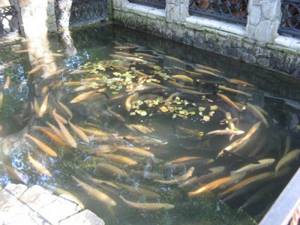
Dependence of the period of carp fishing on climatic conditions
Depending on climatic conditions, there are cycles when the carp bite increases and decreases:
- In early spring, after the ice layer has melted, fishing can begin in clear, warm weather.
- In late spring, spawning begins. The fish are very active, however, fishing is prohibited everywhere at this time.
- In the summer months, after spawning, the fish reduces activity, but after a couple of weeks it begins to actively bite again. The fish's strength is restored and a full search for food begins.
- In winter, carp occasionally bite until the ice covers the entire reservoir. Subsequently, the fish goes deeper and buries itself in the mud until warm days arrive.
With such a cyclical pattern, bites occur annually.
When does carp spawn in the middle zone?
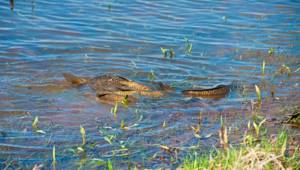
Carp spawning has its own characteristics, since it is more of a heat-loving fish, although it has taken root in the middle zone. Its spawning may begin already at the end of April. In the month of May, it spawns almost en masse, capturing the beginning of June. At the same time, individual individuals can continue to lay eggs until August. But this can be attributed rather to exceptions, so you should not focus on individual individuals. Basically, the signal for the start of spawning is the established warm weather, both during the day and at night. The most optimal period is considered to be the beginning of summer, when the water already has time to warm up to the desired temperature. Although in some cases, carp spawning is possible both earlier and later than the optimal time, depending on the geographical location of the reservoir and the influence of other factors.
Spawning duration
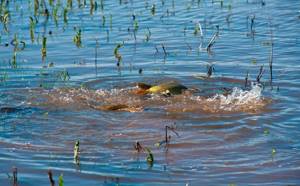
As a rule, the spawning period lasts about one month, but this is when the conditions are favorable, so the spawning period can be prolonged. At the same time, the following sequence should be noted: young carp spawn first, and rather large individuals spawn last. The spawning process may be delayed if during this period the water temperature suddenly drops. In such cases, the fish will wait until the water temperature rises to the desired level.
If we consider the spawning process over one day, then the carp begins the spawning process early in the morning, and finishes it by noon.
At what temperature do carp spawn?

Water temperature plays a major role in the spawning process of fish. With the arrival of spring, when the flood begins, the carp shows increased activity, although this is not yet the period for its spawning. The conditions for laying eggs by carp are:
- The water temperature is about 18-21 degrees.
- In cold water, carp do not lay eggs.
- If at the end of spring or beginning of summer the weather becomes warm, and these are just the conditions for active spawning of carp.
Since spawning depends on the degree of warming up of the water, carp spawn first, which is found in reservoirs with stagnant water, where the water warms up faster. Then the carp spawns in rivers, where the water warms up more slowly due to the presence of a current.
Interesting to know! Despite the fact that the water heats up better when it floods, the carp still lays eggs in the riverbed, as if it knows that if the water level drops sharply, the eggs will disappear. In addition, the spill areas are inhabited by predatory fish, especially pike, which prefer to spawn in such areas.
At what age do carp spawn?
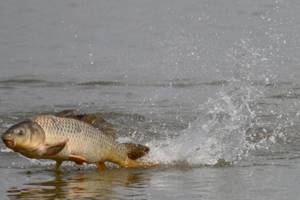
Basically, carp begins to lay eggs when they reach 3-5 years of age. At this point, the carp can reach a length of about 25 centimeters. And again, a lot depends on the nature of the reservoir and the availability of food supply. The more food, the faster the fish grows and becomes sexually mature.
Large carp at spawning
Selecting a place and time for carp fishing
According to experienced fishermen, carp bite best in the early summer morning. During the lunch period, his activity is always low. In the evening, the bites resume again.
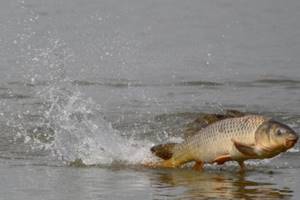
Fishing locations will depend on the period in which the fisherman does it. In spring, preference is given to river mouths and small lakes where the current is very small. Carp at this time are attracted by shallow water. In the summer, before spawning and after it ends, for fishing you need to choose places where the fish feed. In the autumn-winter period, you need to fish in deeper places where the water temperature is higher.
When searching for carp habitats, the following factors should be given importance:
- sufficient depth of the reservoir;
- the presence of reverse and eddy currents;
- clayey-silty bottom;
- presence of irregularities at the bottom.
Choosing gear for carp
A fairly diverse selection of gear is used for carp fishing. It all depends on the choice of the fisherman.
Typically the following points are taken into account:
- A rod over three and a half meters long is considered the most optimal. This is convenient for any fishing. Manufacturers of fishing rods make them with different quality. Companies such as Cormoran, Daiwa, etc. have good recommendations.
- It is advisable for a carp reel to have a small size; it must have a durable body with small spools; it is better to have five bearings. The following brands are considered reliable: Aero, Big, Shimano.
- It is better to take a fishing line made in Japan. Many people recommend 12 Lb to ensure an enjoyable fishing experience. In those reservoirs where there are a lot of snags and other complications, it is better to use 20 Ld fishing line.
- It is better to use a size 6 hook or larger.
- It is better to use the stand as a single mount, separately for each fishing rod . A fairly new product on this market is the rod pod, but it’s a little difficult to choose.
- It is better to use an electronic alarm. The main thing is that it meets certain parameters: sound, water resistance, transmitter, and its additional functions.
- The landing net must have removable parts. It is better if it is light and spacious.
Fishing for carp in late autumn - Video
When using bottom gear or a feeder with a feeder, you should use smaller feeders and at the same time maintain the optimal fishing pace. For this period, 4 casts per hour are sufficient. This will allow you not to get carried away with feeding the carp, and you will also have time to select baits and use dips.
If we talk about baits, then carp are not against eating selected worms, but only a part of such worms can get into the autumn diet. Considering this circumstance, in the autumn you can switch to bloodworms, placing several pieces on the hook at a time. Alternatively, you can use silicone rings to tie several bloodworms into one nice bunch.
It is especially worth dwelling on flavorings, without which modern carp fishing simply does not make sense. Of course, it is necessary to add flavorings, but you should take into account the autumn specifics of fishing associated with fishing in cold water. If you add too much flavoring, it may not only not interest the carp, but also scare it away. This is especially true when fishing in bodies of water where there is no current. When fishing in the current, this is not so important.
The use of flavorings is associated with changes in fish nutrition. In the autumn, the fish switches to a diet in which animal components predominate. Therefore, flavorings should be dominated by the corresponding odors: worm, bloodworm, fish, maggot, etc. At this time, the smells of the summer period, such as fruity and sweet sap, are no longer effective in the autumn period.
The option of adding bone or fish meal, blood, milk powder or ground zebra mussel to the bait will not be very expensive.
We suggest you read: Corn for carp
Without the presence of components of animal origin in the bait, you should not count on a successful fishing outcome. This applies primarily to “wild” reservoirs, where carp are in natural conditions and feed on what they can find in it. As for paid reservoirs, everything is different here. The feeding preferences of the food in such a pond depend on what it is fed, although there is no particular secret. In this case, fishermen, going to a paid reservoir, practically know what carp can be offered.
As you can see, autumn fishing, including carp, is an interesting, but very difficult business. At this time, it is difficult to count on a positive result if you do not have certain skills and appropriate equipment. Skills are necessary in order to be able to find a suitable place, and there is no way to do this without knowledge.
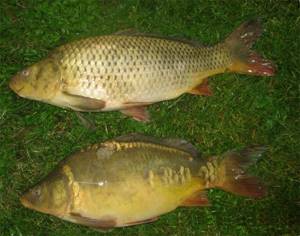
It is necessary to know, first of all, the habits of carp, especially in the autumn. Of no small importance is the knowledge obtained as a result of examining the topography of the bottom of a reservoir, especially an unfamiliar one. Knowledge will also be needed in the process of selecting gear: from the rod to the hook. After all, everyone knows that special carp hooks are used when fishing for carp.
And so, no matter what: it’s better to take a braided fishing line, since it has a high breaking force, with the same diameter. At the same time, thinner fishing line is easier to cast over a long distance. And that is not all! Braided fishing line has a specific stretch, which means that it will transfer the slightest bites to the tip of the rod.
- Bulk mixtures. For example: crackers, fish meal, milk powder. These mixtures are like an aromatic cloud to which the carp swim with great pleasure;
- Grain mixtures. For example: porridge, bran, corn, hemp, pellets (granulated food);
- Live food. For example: bloodworms, maggots, worms;
- Boilies. The composition of the boilie is always different. Its composition may include: dyes, cereals, starch, flavorings, flavoring additives, etc.;
- Nuts are a heavy food, but if adequate proportions are observed, the taste will be unusual, which will attract fish;
- Fruit supplements are supplements that consist of fruits.
How to catch more fish?
I have been active fishing for quite some time and have found many ways to improve the bite. And here are the most effective:
- Bite activator. Attracts fish in cold and warm water with the help of pheromones included in the composition and stimulates its appetite. It’s a pity that Rosprirodnadzor wants to impose a ban on its sale.
- More sensitive gear. Reviews and instructions for other types of gear can be found on the pages of my website.
- Lures using pheromones.
You can get the rest of the secrets of successful fishing for free by reading my other materials on the site.
Fishing on a feeder
It is better to catch carp on a feeder after it has spawned, but for this you need to have patience. Interestingly, this type of fishing does not allow the fish to be overfed.
The following equipment is used:
- The rod size is 3.6 - 4 meters.
- Reel spool up to 3000.
- The fishing line is chosen based on the size of the prey.
- Hook from number six to number eight.
- Use an appropriate leash.
- The feeder should weigh from thirty to seventy grams. This is a rather important element that must have maximum aerodynamic properties.
Flavoring of groundbait
In spring, do not forget that carp are just becoming more active. The water temperature is low, so alcohol-based flavorings are a good help.
They promote better distribution in the aquatic environment and can change the smell of bait. Manufacturers always indicate on flavoring agents and flavor enhancers at what water temperature they can be used efficiently.
At the beginning of spring, you can use flavors that smell like garlic, worms, they can smell like crayfish necks, blood, or fish oil. All sweet flavors are applicable.
Using a float rod
It is believed that catching carp with a float rod is more convenient than with a feeder, since carp prefer to look for food close to the shore.
The float rod is equipped as follows:
- The rod sizes range from four to six meters.
- It is better to use an inertia-free reel that has a sensitive friction brake.
- The fishing line should be from three and a half kilograms, depending on the size of the fish you are catching. Of course, it is advisable to have a set of fishing lines so that, if necessary, you can change it to a stronger one.
- The float can be of any shape, but its end must be sharp, then its sensitivity in water will be higher.
- The quality of the hook must be good.
Using attachments
As bait in the spring, you can use dung or earthworms, mollusks, insects, crustaceans. With the onset of summer, the use of boilies, corn, and potatoes begins. It is possible to use ready-made nozzles.
In the spring, it is better not to use bait, as the fish have become hungry over the winter. It’s better to throw boilies a couple of times during fishing. Boilies are a special composition that attracts fish and has a fairly effective effect on the results of fishing.
It contains a protein component with a high degree of nutritional value, a carp-attracting flavoring agent and a binder. Don't forget to dress appropriately for fishing so as not to freeze or get wet. Use all of the recommendations listed and you are sure to have a catch.
What to feed for fast growth
With proper feeding of the carp, in just 9 months the fry can be grown into an individual fish weighing up to 0.5 kg. Fish of the carp family are omnivorous. They readily feed on bloodworms, worms, insect larvae, barley, wheat, steamed rice, and rye bread crumbs.
Feeding carp should be done twice a day at the same time:
- In the morning, when the water has already warmed up under the sun's rays.
- In the evening before sunset.
Because of its omnivorous nature, the carp is often called the “pond pig.” But for proper breeding of carp in a pond, it is necessary to be especially careful when choosing food.
The following types of food should be given to the fish:
Compound feed
It contains fishmeal, bran, wheat, soybean and sunflower meal, etc. It can also be used for feeding mixed feed that is fed to chickens and livestock. You need to mix it with water in advance. Add as much water as needed to obtain a dough-like consistency.
Legumes and cereals
They should not be used for regular meals. They should first be soaked in water for several hours. Peas and beans are first steamed to rid the beans of toxic substances present in them.
Protein food
This necessary and useful type of food for burl fish is represented by bloodworms, worms, snails, maggots, etc. The maximum need for protein food occurs in spring and autumn. But it is recommended to provide protein year-round to prevent the development of digestive system diseases in fish.
Potato
The root vegetable is given to the fish after boiling it. Since the nutritional value of potatoes is low, it is better to mix them with fish meal or protein supplement.
Bread and cake
It is better to use them together with grain or grain waste.
Young grass
Before feeding, soft grass (woodlice, lupine, clover, etc.) should be chopped.
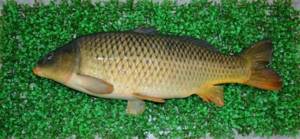
Insects
Carp happily eat insects, but catching them is not an easy task. But most insects fly to the light, so you can install lamps near the pond or stretch a garland over the surface of the water. They only need to be turned on at night. Having flown to the glow, the insects will certainly fall into the water, becoming food for the fish.
